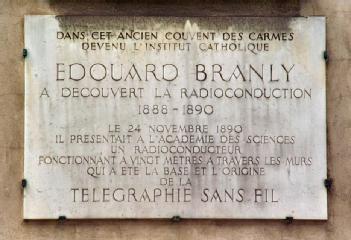
Musée Édouard Branly |
75006 Paris, France (Île-de-France) |
|
| Address |
ICP Institut Catholique de Paris
21, rue d'Assas |
| Floor area | unfortunately not known yet |
Science Museums in general
- Electricity / Magnetism
- Optics
- Telephone / Telex
- Morse technology
- Physics
|
Opening times
|
Museum accessible only by appointment
Musée accessible uniquement sur Rendez-Vous
|
||||
|
Status from 03/2023
|
We don't know the fees. | ||||
| Contact |
|
||||
| Homepage | www.icp.fr/vie-du-campus/un-campus-au-coeur-de-paris/musee-edouard-branly | ||||
| Location / Directions |
The Musée Édouard Branly is a museum dedicated to the work of radio pioneer Édouard Branly (1844-1940). It is located in the 6th arrondissement at the Institut Catholique de Paris-ISEP, 21, rue d'Assas, Paris, France. Métro : Saint-Placide, Rennes Bus : 89, 95, 96, 94 |
| Description | The cultural heritage of the Institut Catholique de Paris also includes the Edouard Branly Museum. It was in his laboratory that Professor Branly, a teacher-researcher at the Institut Catholique de Paris in the 1875s, made the first wireless telegraphy transmission in 1890. Built by the architect Paul Tournon in 1932, the Edouard Branly Museum is the former laboratory of Edouard Branly (1844-1940). It houses a collection of instruments described in his works. His publications also mention the orientations and areas of research he considered to be of capital importance, namely "radiant heat, optics and electricity". The research that has contributed most to spreading Professor Branly's reputation is that which led him to the discovery of the principle of wireless telegraphy and the application of "radioconductors to telematics". The results of his research are notably exposed in numerous communications addressed to the Academy of Sciences. Attached to the Institut Catholique de Paris, the physicist's laboratory has now become the present Musée Branly; it perpetuates its memory. To go through the showcases presenting the apparatus used by the scientist, to see the rooms of his laboratory, his office and the "copper room", is to follow as closely as possible the itinerary of the museum. of this great scientist and glimpse the era of the history of science in which he is involved. Wikipedia: |
| Description (other) |
Wikipedia: |
[dsp_museum_detail.cfm]
| Data Compliance | More Information |

